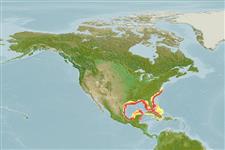分類 / Names
共通名の | 類義語 | Catalog of Fishes(部類, 種) | ITIS | CoL | WoRMS | Cloffa
Environment: milieu / climate zone / depth range / distribution range
生態学
海 底生の漂泳性; 深さの範囲 2 - 275 m (Ref. 53006), usually 155 - 225 m (Ref. 53006). Subtropical; 39°N - 17°N, 99°W - 73°W
Western Atlantic: entire Gulf of Mexico, from Tampa region in Florida, USA to Yucatan in Mexico; also in Virginia to northeastern Florida, USA (but possibly representing P. tricanthus instead, Ref. 53006).
Length at first maturity / サイズ / 重さ / 年齢
Maturity: Lm 13.0, range 10 - 16 cm
Max length : 25.0 cm TL オス/雌雄の選別がない; (Ref. 7251)
簡単な記述
検索表 | 形態学 | 形態計測学
This species is distinguished by the following characters: body oval, deep (its depth less than 2.5 times in total length) and strongly compressed; eye surrounded by a small area of adipose tissue; snout short and blunt, lower jaw projecting somewhat beyond upper; mouth small, tip of maxillary not reaching below eye margin; teeth in jaws very small, in one row while those in the upper jaw flattened and with 3 tiny cusps; dorsal and anal fin bases very long (about equal in length), the anterior fin rays elevated, but fins not falcate, and both fins preceded by 3 short, weak, spines; caudal fin deeply forked; pectoral fins long (longer than head) and pointed; pelvic fins absent; distinct series of 17 to 25 pores along anterior half of body under the dorsal fin; lateral line high, following dorsal profile; scales small, present also on cheeks; caudal vertebrae 16 to 18; body color pale blue above, silvery below (fading after death), no spots (Ref. 53006).
A pelagic fish forming large loose schools across the continental shelf over sand/mud bottoms; depth range from 2 to 275 m at least, but most abundant at 155 to 225 m; found near the bottom during the day and migrating into the water column at night. Juveniles often found under floating weeds and with jellyfish. Adults feed on jellyfish, small fish, crustaceans, and worms; the juveniles are plankton and jellyfish feeders. Mature within 1 year and rarely lives past 2; spawning takes place at discrete intervals twice a year slightly offshore. Highly esteemed for food, marketed fresh and frozen; caught mainly with otter trawls (Ref. 53006).
Life cycle and mating behavior
Maturities | 繁殖 | Spawnings | Egg(s) | Fecundities | 幼生
Robins, C.R. and G.C. Ray, 1986. A field guide to Atlantic coast fishes of North America. Houghton Mifflin Company, Boston, U.S.A. 354 p. (Ref. 7251)
Human uses
水産業: 商業
用具
特記事項
XMLをダウンロードして下さい
インターネットの情報源
Estimates based on models
Preferred temperature (Ref.
123201): 14.7 - 22.3, mean 18.1 °C (based on 26 cells).
Phylogenetic diversity index (Ref.
82804): PD
50 = 0.5020 [Uniqueness, from 0.5 = low to 2.0 = high].
Bayesian length-weight: a=0.01380 (0.00744 - 0.02562), b=3.01 (2.85 - 3.17), in cm total length, based on LWR estimates for this species & Genus-body shape (Ref.
93245).
栄養段階 (Ref.
69278): 4.0 ±0.28 se; based on food items.
Generation time: 0.7 ( na - na) years. Estimated as median ln(3)/K based on 2
growth studies.
回復力 (Ref.
120179): 高い, 15か月以下の倍増期間の最小個体群 (tm=1; tmax=2; k >0.3).
Fishing Vulnerability (Ref.
59153): Low vulnerability (12 of 100).
